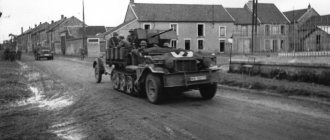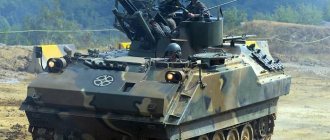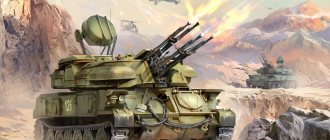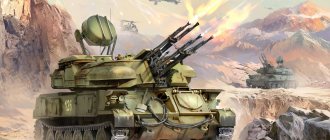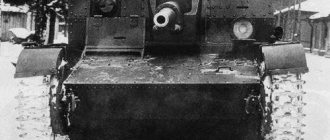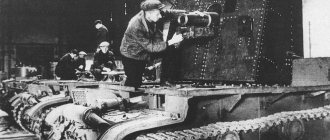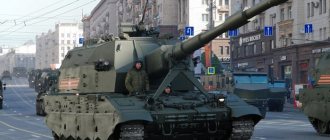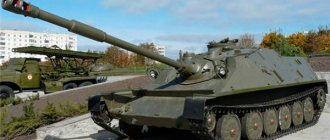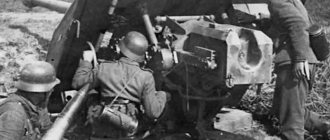| This article includes a list of common links, but it remains largely unverified because it lacks relevant embedded links . |
Type of self-propelled anti-aircraft gun
| Flakpanzer 38 (t) | |
| Type | Self-propelled anti-aircraft gun |
| Place of origin | Nazi Germany |
| Service history | |
| In service | 1944–1945 |
| Wars | The Second World War |
| Production history | |
| Produced | 1943–1944 |
| No. built | 141 |
| Characteristics | |
| Weight | 9,800 kg (21,600 lb) |
| Length | 4.61 m (15 ft 1 in) |
| Width | 2.15 m (7 ft 1 in) |
| Height | 2.25 m (7 ft 5 in) |
| Crew | 4 |
| Armor | 10 mm - 15 mm |
| Main weapons | 1 x 2 cm FlaK 38 L / 65 1040 rounds |
| Engine | 1 x Praga AC, 6-cylinder petrol engine 147 hp (110 kW) |
| Power/weight | 15 hp / ton |
| Suspense | Leaf spring |
| Operating range | 210 km (130 mi) |
| Maximum speed | 42 km/h (26 mph) |
Flakpanzer
38 (t)
, officially named Flakpanzer 38 (t) Auf Selbstfahrlafette 38 (t) Ausf M (Sd.Kfz. 140)
, was a German self-propelled anti-aircraft gun used in World War II. It is sometimes incorrectly called the Gepard, which can lead to confusion with the unrelated Flakpanzer Gepard.
History[edit]
The fate of the battles of the Second World War was often decided by tank wedges, breaking into defenses like a can opener through a tin. The fight against tanks became a priority, and all available means were allocated for it, including aviation. In turn, this required the creation of effective anti-aircraft weapons capable of accompanying tank formations. The optimal solution seemed to be the installation of anti-aircraft guns on tank chassis - this immediately removed the problem of ensuring mobility equal to tanks. The Germans were among the first to create highly mobile anti-aircraft self-propelled guns (ZSU). The development of such machines began in 1940.
For a couple of years, the Wehrmacht made do with self-propelled anti-aircraft guns on half-track chassis. The Germans made a new attempt to create a ZSU on a tank base only two years later, and the decision was made with the direct participation of Hitler. In May 1943, at a meeting on the design of the super-heavy Maus tank, he proposed including a 37-mm naval-style twin anti-aircraft gun in the supertank's armament. The military greeted this idea coolly, but they could not ignore it - after all, it was the Fuhrer himself who proposed it.
Further discussion led to the idea that it is not necessary to mount the anti-aircraft gun on the Maus; it would be more expedient to create a separate ZSU capable of covering not only the Maus, but also other types of tanks. A chassis suitable in terms of load-carrying capacity that could withstand a 37 mm twin was not available. At the beginning of September 1943, Hitler, reluctantly, was forced to agree to a “temporary” ZSU, armed with a 20-mm single-barreled machine gun - the same as on the Flakpanzer I.
In 1939, the Czechoslovak Army created a new tank, the LT vz.38. These tanks had very well balanced firepower, armor and mobility, were easy to maintain and had high reliability. After the occupation of the Czech Republic and Moravia, the German Army Weapons Directorate (Waffenamt) became interested in these tanks and the Germans took over the entire order that ČKD was working on. In the German army the tank received the designation PzKpfw 38(t). As the base for the new anti-aircraft gun, we chose the chassis of this famous light tank of Czechoslovak design, adapted for self-propelled artillery by moving the engine compartment to the middle part of the vehicle, and the combat compartment to the rear.
Many other armored fighting vehicles were built on the basis of the tank. The Flakpanzer 38 (t) anti-aircraft tank is the latest installation developed on the basis of the PzKpfw 38 (t) tank chassis of modification M or L. According to technical specifications. According to the assignment, the anti-aircraft gun fire was supposed to be circular.
On October 15, 1943, on the personal instructions of Hitler, Prague ordered the production of 150 self-propelled anti-aircraft guns equipped with one 20-mm automatic cannon, but even before the design was completed, the order was reduced to 140 units. In November 1943, the first installation left the factory floor, and by the end of the year 101 anti-aircraft self-propelled guns were handed over to the customer. The remaining 40 units of equipment were delivered in January–February 1944.
The anti-aircraft tank was the lightest among the installations created on the basis of the 38(t) tank, its weight was 9.7 tons, due to which the vehicle had the best maneuverability and developed the highest maximum speed. However, a single cannon was unable to provide sufficient fire density when firing at air targets, even in cases where a group of vehicles was used. However, it must be borne in mind that the Flakpanzer 38(t) is an intermediate option. Vehicles of this type were in service with units of several divisions for a relatively short time. In addition to the SdKfz 140, there was another anti-aircraft tank on the 38(t) chassis, but the circumstances of its creation are not known. According to factory documentation from 1944, it was planned to convert 2 vehicles of an unspecified type into self-propelled anti-aircraft guns.
Anti-aircraft self-propelled gun Flakpanzer 38(t) / Panzerkampfwagen 38(t) für 2 cm FlaK 38 (Germany)
The Flakpanzer I anti-aircraft self-propelled guns partially solved an important problem, but failed to have a noticeable impact on the course of the battles. This result was caused by the small number of similar vehicles (only 24 units), as well as the outdated chassis of the mid-thirties with little remaining service life. As a result, some of the SPAAGs of this type were lost in battle, and the last vehicles fell into the cauldron at Stalingrad. There they first became a trophy of the Red Army, and then turned into scrap metal. However, the Wehrmacht still needed a self-propelled system capable of protecting troops from air attack. The next attempt to build such a vehicle was the Flakpanzer 38(t) project. An interesting fact is that the new Flakpanzer project started only in the first half of 1943 - only a couple of years after the start of work on the Flakpanzer I and a few months after the loss of the last such self-propelled guns. According to some reports, this was due to the peculiarities of the situation at the front. German aviation still maintained air supremacy, and towed systems also coped with air defense tasks. For this reason, the development of a new ZSU was considered desirable, but was not a priority. However, over time, the situation on the fronts changed, which led to corresponding consequences.
In the first half of 1943, the company Böhmisch-Mährische Maschinenfabrik AG (BMM, now Českomoravská Kolben-Daněk), operating in occupied Prague, began creating a new self-propelled gun with anti-aircraft weapons. In order to accomplish the task, it was decided to widely use existing units. In particular, the basis for the combat vehicle was to be the existing chassis, created on the basis of one of the previous developments. The armament also did not have to be developed from scratch: it was decided to use an existing automatic cannon, similar to that used on the Flakpanzer I.
ZSU Flakpanzer 38(t). Photo Panzer-archiv.de
The main element of the promising vehicle was to be the Selbstfahrlafette 38(t) Ausf.M tracked chassis. This vehicle was a redesigned chassis of the Pz.Kpfw.38(t) light tank with a modified layout and a redesigned hull. By the middle of the war, the original light tank no longer fully met the requirements for combat vehicles, but could still be used as the basis for auxiliary equipment. Based on this logic, Czech specialists developed a modified chassis, which was planned to be used in the construction of various self-propelled artillery mounts and other equipment.
In the new project, it was planned to equip the base chassis with some additional units that would turn it into a self-propelled anti-aircraft gun. First of all, it was necessary to provide for the installation of an anti-aircraft gun and protection for the crew. At the same time, it was possible to reduce the necessary modifications to the chassis by using the maximum number of ready-made units.
The multi-purpose tracked chassis Selbstfahrlafette 38(t) Ausf.M was a redesigned version of the base Pz.Kpfw.38(t) tank of Czechoslovak design. This vehicle retained most of the features of the original tank, but differed in some design features. The most important difference was the layout of the case. It was assumed that such a chassis would be used in the construction of self-propelled artillery mounts with a rear-mounted fighting compartment. In this regard, the engine compartment was moved from the rear of the hull to its middle part, which freed up space to accommodate weapons and crew. The rest of the chassis units were as unified as possible with the tank.
Light tank Pz.Kpfw.38 (t). Photo: Wikimedia Commons
The Czechoslovak light tank had armor up to 25 mm thick and could protect the crew from small arms or small-caliber artillery systems. In the front part of the Selbstfahrlafette 38(t) Ausf.M chassis there were transmission units interacting with the drive wheels, as well as the driver’s workplace. Directly behind them was the engine compartment with a 150 hp gasoline engine connected to the front transmission units via a driveshaft.
The universal chassis retained the chassis of the base vehicle. On each side there were four road wheels, interlocked in pairs, with a suspension based on leaf springs. The drive wheels were located in front, the guides were located at the rear. The chassis also included four support rollers (two per side), on which the front and middle parts of the upper branch of the caterpillar lay. There was no additional support for the rear half: it had to rest on the rear road wheels and transfer to the idler wheel.
It was proposed to install a wheelhouse in the stern of the base chassis to accommodate weapons and weapons. A structure of complex polygonal shape, consisting of 10 mm armor plates, had to be built over the sides of the existing hull. The frontal sheets of such a cabin were installed at an angle to the vertical with an inclination back, and the sides and stern were made wedge-shaped. All elements of the cabin consisted of two plates connected by hinges. Thus, if necessary, the crew could lower the upper frontal or side sheets, increasing the horizontal and vertical aiming angles.
Inside the aft superstructure, a stand was placed for mounting the FlaK 38 automatic cannon of 20 mm caliber along with part of the original carriage. The gun retained the ability to aim horizontally in a circular direction. Vertical guidance could be made within the range from -5° to +90°, which made it possible to shoot at both air and ground targets. The gun carriage, almost completely borrowed from the original towed design, had its own gunner's workplace with manual aiming drives, a sight and an armor shield for protection from fire from the front.
One of the production cars. Photo Panzernet.net
The FlaK 38 gun had a 20 mm rifled barrel with a length of 65 calibers and was intended to attack enemy aircraft at low altitudes. The gun could fire at a rate of up to 450 rounds per minute (practical rate of fire no more than 180-200 rounds per minute) and hit targets at ranges of up to 2.2 km. The ammunition load could include several types of shells, including high-explosive fragmentation, armor-piercing, etc. Ammunition was supplied from interchangeable magazines with a capacity of 20 shells.
The new self-propelled gun was to be operated by a crew of four people. At the same time, control of the chassis was entrusted to only one driver, and a crew of three people had to be responsible for servicing the gun.
Due to the use of a chassis based on the design of a light tank, the finished combat vehicle turned out to be relatively compact and not very heavy. The combat weight was determined to be 9.8 tons, the length was 4.6 m, the width was 2.13 m, and the height was 2.25 m.
The design of an anti-aircraft self-propelled gun based on the Selbstfahrlafette 38(t) Ausf.M chassis was completed in mid-1943. Soon the first prototype was built and used during testing. Overall, the car performed well. The existing engine allowed it to accelerate on the highway to 40-42 km/h, and on rough terrain the maximum speed was halved. The power reserve, depending on the route, was 140-185 km. With a specific power of more than 15 hp. per ton, the self-propelled gun could overcome various obstacles. Thanks to its mobility, the vehicle had the ability to move and work in the same combat formations with tanks and other armored vehicles in service.
View from above. Photo Panzernet.net
The 20-mm FlaK 38 automatic cannon used was already actively used by anti-aircraft formations and managed to prove itself well. However, due to the increase in aviation speeds, the real effectiveness of these weapons gradually decreased. In the long term, arming the ZSU with just one automatic cannon no longer looked sufficient. However, in the case of the new BMM project this was considered acceptable. Probably, one of the main arguments in favor of the new self-propelled gun was the virtual lack of alternatives and the urgent need for such means of protection against attack from the air.
In the fall of 1943, the prototype of the anti-aircraft self-propelled gun passed all tests, after which the new equipment was put into service. According to the rules of the German nomenclature of ground forces equipment, the SPAAG received the complex designations Panzerkampfwagen 38(t) für 2 cm FlaK 38 (“Panzerkampfwagen 38(t) chassis for the 2 cm FlaK 38 gun”) and Sonderkraftfahrzeug 140 (“Special purpose vehicle, model 140 "). In addition, by analogy with the previous project, the designation Flakpanzer 38(t) appeared - “Anti-aircraft tank based on Pz.Kpfw.38(t).” All these designations are used equally in different sources and documents.
After the new Flakpanzer was put into service, BMM received an order for the serial construction of such equipment. This company has been building Panzerkampfwagen 38(t) tanks for the past few years, and also relatively recently launched production of the Selbstfahrlafette 38(t) Ausf.M universal chassis. Thus, no serious problems with the production of self-propelled guns were expected. However, for objective reasons, such as being loaded with other orders, the production rate of the new ZSU in practice left much to be desired. In accordance with the concluded contract, over the next few months the Prague plant was to build 150 new combat vehicles.
ZSU with folded sides. Photo Panzernet.net
[/center]
During the first few months of series production, BMM was able to fulfill most of the order. By the end of January, 87 anti-aircraft self-propelled guns were built and handed over to the troops. After this, production continued, but its pace was constantly declining. The last production Flakpanzer 38(t), according to various sources, left the assembly shop in 1944. In total, the troops received 141 vehicles of the new type out of 150 ordered.
In September 1944, production of the Panzerkampfwagen 38(t) für 2 cm FlaK 38 self-propelled gun was finally discontinued. The reason for this was the deployment of mass production of the new anti-tank self-propelled gun Jagdpanzer 38(t), entrusted to BMM. The plant could not simultaneously build both vehicles in the required quantities, which is why the anti-aircraft self-propelled guns were discontinued. In addition, by the fall of 1944, new models of equipment for similar purposes with higher characteristics were adopted. After the deployment of their full-fledged production and rearmament of troops, the need for older equipment could completely disappear.
Serial combat vehicles of a new type were sent to serve in various units of the German army. Without wasting time, the ground forces threw self-propelled guns into battle with enemy aircraft. Having armament in the form of one 20-mm automatic cannon, such equipment could withstand raids, but in some cases the firepower could only be acceptable when several vehicles were operating simultaneously. At the same time, anti-aircraft armored vehicles in some cases could be used to destroy enemy ground forces, primarily light equipment and infantry. In this case, a certain effectiveness of fire was achieved, but there was a risk of being subjected to retaliatory fire with fatal consequences. Despite all the problems, the operation of the Flakpanzer 38(t) self-propelled gun continued on an uncontested basis.
American soldiers rest after the battle. In the background is a broken Flakpanzer 38(t) self-propelled gun. Normandy, 1944. Photo: Wikimedia Commons
According to available data, the Panzerkampfwagen 38(t) für 2 cm FlaK 38 self-propelled gun began its service on the Eastern Front, and after the landing in Normandy, a number of such vehicles were transferred to Western Europe. For obvious reasons, anti-aircraft weapons, including those on self-propelled chassis, were a priority target for Allied strike aircraft. Because of this, anti-aircraft units armed with Flakpanzer-38 constantly suffered losses. As the offensive of the anti-Hitler coalition troops progressed, the losses only intensified.
Some sources mention that by the beginning of the winter of 1944, no more than a dozen combat-ready Flakpanzer 38(t) vehicles remained in combat units in Germany out of almost one and a half hundred built. Soon after this, the self-propelled guns that remained in service shared the fate of their less fortunate brethren, who died a little earlier. By the end of the war in Europe or a little earlier, all ZSUs of this type were destroyed in battles under certain circumstances. Not a single such machine has survived to this day.
The Flakpanzer 38(t) / Panzerkampfwagen 38(t) für 2 cm FlaK 38 / Sd.Kfz.140 project was a continuation of German work on the subject of anti-aircraft self-propelled artillery for air defense of troops on the march and in positions. Compared to the previous Flakpanzer I project, the new vehicle turned out to be quite successful and had a lot of advantages. In addition, she managed to go into mass production in much larger volumes. However, 24, 141, and even 150 combat vehicles with automatic cannons could not seriously influence the course of battles in Europe. To effectively counter enemy aircraft, Germany required a much larger number of anti-aircraft self-propelled guns, the construction of which, however, was almost impossible or extremely difficult. As a result, over time, the anti-Hitler coalition gained air superiority and thereby brought victory much closer.
Based on materials from the sites: https://achtungpanzer.com/ https://armor.kiev.ua/ https://panzer-archiv.de/ https://panzernet.net/
Construction[edit]
Hull and armor[edit]
Layout of Flakpanzer 38(t) using the example of the game “War Thunder”.
Flakpanzer 38 used a rearranged chassis of the Pz 38(t) light tank, which was also used to create a number of other self-propelled guns. The Flakpanzer 38 had a layout with the transmission compartment located in the frontal part of the hull, the control compartment behind it, the engine compartment in the middle part of the hull, and the combat compartment in the stern. The ZSU crew consisted of four people - a driver, located in the control department; commander, who also served as a gunner, loader and radio operator, located in the fighting compartment.
The design of the self-propelled gun was very simple, although not as primitive as that of the Flakpanzer I. The self-propelled gun was assembled using rivets, even though by the end of 1943 they tried to use welding more. The thickness of the hull armor did not exceed 10-25 mm. The driver's armored cap was made by casting, as on early self-propelled guns and tank destroyers. A 20-mm single-barreled anti-aircraft gun was installed on the Flakpanzer 38(t) in an open-top cabin, octagonal in plan (the upper parts of the cabin walls could be folded down) made of 10-mm armor plates. This solution provided much better protection for the crew than that of the Flakpanzer I. The anti-aircraft gun cabin, compared to the cabin of a tank destroyer or self-propelled gun, was moved back and had a much lower height. The open top of the cabin was formed by 10-mm armor plates. The cabin armor provided protection from shrapnel and bullets to the crew. At the same time, the crew remained unprotected from air attacks. The stern and side walls of the cabin were tilted to a horizontal position. This configuration of the fighting compartment made it possible to fire at ground targets from a 20-mm Flak 38 automatic anti-aircraft gun at a maximum descent angle of -5 degrees. Directly in front of the gun, two frames were installed, which limited the angle of descent when firing forward. This was done to exclude the possibility of shells hitting the front part of the installation’s body. Thanks to the rear location of the wheelhouse, it is possible to increase the removable over-engine panels for easier maintenance. At the same time, access to the radiator became dramatically more difficult; now, in order to get to it, several panels had to be removed in the lower part of the cabin.
| Flakpanzer 38(t) armor | |
| Armor type | rolled steel surface hardened |
| Body forehead (top) | 20 mm / 20° |
| Body forehead (middle) | 10 mm / 65° |
| Body forehead (bottom) | 20 mm / 15° |
| The ship's side | 15 mm / 0° |
| Hull stern | 10 mm / 45° |
| Housing roof | 8 mm |
| Forehead cutting | 10 mm / 20° |
| Cabin side | 10 mm / 17 – 25° |
| Feed cutting | 10 mm / 25° |
Weapons[edit]
2 cm Flak 38 which was installed in the ZSU.
The only armament of the Flakpanzer 38 was the 20-mm automatic anti-aircraft gun 2.0 cm FlaK 38 (German: 2.0 cm Flugzeugabwehrkanone 38 - 2-cm anti-aircraft gun of the 1938 model), developed by . The gun was placed on the floor in front of the fighting compartment on a pedestal installation, which allowed its circular rotation and vertical aiming within the range of −5...+90°. The barrel length is 65 calibers, and the effective firing range is 2200 m. The theoretical rate of fire of the gun was 420-480 rounds per minute, but in practice it did not exceed 100-120 rounds per minute. The barrel wear limit was reached after approximately 10,000 - 12,000 shots. Ammunition was supplied from 20-round magazines. The operating principle of the mechanisms of the FlaK 38 assault rifle is the use of recoil force with a short barrel stroke.
, a Schwebekreis-Visier Erdzielfernrohr 3×8 telescopic sight was used
, providing a magnification of 3× and a field of view of 8°.
The gun's ammunition capacity was 1040 unitary rounds in clips of 20 pieces: 36 with anti-aircraft 2 cm Br.Spgr
and 16 armor-piercing
2 cm Pzgr
.
Image
Name
Description
Performance characteristics of the Flak 38 L/65 anti-aircraft gun[2]
Panzergranate 39 (PzGr.39)
- Projectile type: armor-piercing
- Caliber: 20 × 138 mm
- Projectile length: 85 mm
- Weight: 0.33 kg
- Initial projectile speed: 830 m/s
Panzergranate 40 (PzGr.40)
- Projectile type: armor-piercing
- Caliber: 20 × 138 mm
- Projectile length: 85 mm
- Weight: 0.14 kg
- Initial projectile speed: 900 m/s
Sprenggranate (SpGr)
- Projectile type: anti-aircraft
- Caliber: 20 × 138 mm
- Projectile length: 85 mm
- Weight: 0.3 kg
- Initial projectile speed: 830 m/s
Engine and transmission[edit]
An in-line 6-cylinder Praga AC liquid-cooled carburetor engine with a power of 150 hp was installed in the middle part of the hull. Specific power – 15.3 l. s./t. Cruising range on the highway is 185 km. Cruising range over rough terrain – 140 km. A mechanical type transmission was installed in the front part of the body. Gearbox: 5 forward, 1 reverse.
Chassis[edit]
The chassis of the Flakpanzer 38 Christie type did not undergo any changes compared to the base tank and consisted of four single rubber-coated road wheels with a diameter of 775 mm, a idler wheel with a diameter of 535 mm with a tension mechanism, and a cast dual drive wheel with 19 teeth. The road wheels were interlocked into bogies of two in balance bogies suspended on semi-elliptical springs. At the top of the hull there were two small support rollers[3].
The Flakpanzer 38 caterpillar is steel, fine-linked, double-ridged, lantern gear. Each caterpillar consisted of 94 tracks with a width of 293 mm and a pitch of 104 mm. Specific ground pressure – 0.64 kg/cm².
Obstacles to be overcome:
- Rise – 30 degrees;
- Wall – 0.75 m;
- Ditch – 1.8 m;
- Ford – 0.90 m.
Surveillance and communications equipment[edit]
Radio equipment – one Fu 5 radio station.
General characteristics of Flakpanzer 38
- Country : Germany
- Type of equipment ZSU
- Rank 1
- Battle rating in arcade mode 2
- realistic mode 2
- simulator mode 2
More options
Advanced options
Arcade mode
- Weight 9.8 tons
- Price 6,300€
- Reward 30%
- Research bonus 106%
- shot_freq 480 Rounds per minute
- Crew training price 1,800€
- Visibility 77%
- Reload time 3.9 s
- 10 free repairs
- Power 213 l. With. at 2600 rpm
- Max. speed 46 km/h
- Climbability 40°
- Repair price 370€
- Gun 20 mm FlaK38 cannon (Ammo: 1080)
- Turret rotation 30.8°/s
- armor_piercing_100 46 mm
- armor_piercing_500 45 mm
- armor_piercing_1000 33 mm
- Weapon sets 1
- Free repair time 20m.
- Hull (stern) armor 10 mm
- Hull armor (side) 15 mm
- Hull armor (forehead) 20 mm
- Turret (stern) armor 5 mm
- Turret armor (side) 5 mm
- Vert. aiming angles (max) 90°
- Vert. aiming angles (min) -10°
- Turret armor (front) 7 mm
Realistic mode
- Weight 9.8 tons
- Price 6,300€
- Reward 50%
- Research bonus 106%
- shot_freq 480 Rounds per minute
- Crew training price 1,800€
- Visibility 77%
- Reload time 3.9 s
- 10 free repairs
- Power 133 l. With. at 2600 rpm
- Max. speed 42 km/h
- Climbability 40°
- Repair price 370€
- Gun 20 mm FlaK38 cannon (Ammo: 1080)
- Turret rotation 20.8°/s
- armor_piercing_100 46 mm
- armor_piercing_500 45 mm
- armor_piercing_1000 33 mm
- Weapon sets 1
- Free repair time 33m.
- Hull (stern) armor 10 mm
- Hull armor (side) 15 mm
- Hull armor (forehead) 20 mm
- Turret (stern) armor 5 mm
- Turret armor (side) 5 mm
- Vert. aiming angles (max) 90°
- Vert. aiming angles (min) -10°
- Turret armor (front) 7 mm
Simulator mode
- Weight 9.8 tons
- Price 6,300€
- Reward 70%
- Research bonus 106%
- shot_freq 480 Rounds per minute
- Crew training price 1,800€
- Visibility 77%
- Reload time 3.9 s
- 10 free repairs
- Power 133 l. With. at 2600 rpm
- Max. speed 42 km/h
- Climbability 40°
- Repair price 520€
- Gun 20 mm FlaK38 cannon (Ammo: 1080)
- Turret rotation 20.8°/s
- armor_piercing_100 46 mm
- armor_piercing_500 45 mm
- armor_piercing_1000 33 mm
- Weapon sets 1
- Free repair time 37m.
- Hull (stern) armor 10 mm
- Hull armor (side) 15 mm
- Hull armor (forehead) 20 mm
- Turret (stern) armor 5 mm
- Turret armor (side) 5 mm
- Vert. aiming angles (max) 90°
- Vert. aiming angles (min) -10°
- Turret armor (front) 7 mm
Statistics on Flakpanzer 38 for 1 month
These statistics are collected on players who visited our site and cannot be used to point out problems to developers, as they are not complete. Arcade mode
- Number of battles 230
- Win rate 70.22%
- Air frags per battle 0.25
- Air frags per death 0.24
- Ground frags per battle 3.79
- Ground frags per death 3.46
Realistic mode
- Number of battles 533
- Win percentage 63.27%
- Air frags per battle 0.46
- Air frags per death 0.43
- Ground frags per battle 2.21
- Ground frags per death 2.11
Simulator mode
- Number of battles N/A
- Win percentage N/A
- Air frags per battle N/A
- Air frags per death N/A
- Ground frags per battle N/A
- Ground frags per death N/A
Combat use[edit]
In accordance with its purpose, the Flakpanzer 38(t) ZSU entered service with the tank divisions of the Wehrmacht and SS troops. Deliveries of the ZSU began in November 1943. One installation was inspected by Hitler on December 16, who gave the order to immediately accept anti-aircraft tanks into service with tank divisions as soon as possible. They equipped air defense tank platoons (Panzer-Flugabwehr-Zug) as part of tank regiments. According to K.St.N. 1195, such a platoon consisted of twelve ZSUs, grouped into three groups of four units. In practice, most often, eight anti-aircraft guns were left at the disposal of the regiment commander, and the rest were distributed in twos between the two tank battalions that made up the regiment.
The formation of anti-aircraft platoons began in February 1944; 10 days were allotted for the formation of a platoon. According to the plans, two platoons consisting of twelve anti-aircraft tanks were to be formed every ten days. Each platoon had three sections of four vehicles each. As a rule, two groups were at the disposal of the division headquarters, the remaining anti-aircraft tanks were intended for air defense of the headquarters of tank regiments.
The first to receive them were the 2nd and 21st Panzer Divisions (TD), the 130th Training Division, as well as three SS tank divisions: the 9th Hohenstaufen, the 10th Frundsberg and the 12th Hitler Youth. . However, in May 1944, the air defense platoons of the 9th and 10th SS TD were transferred to the 1st SS TD Leibstandarte SS Adolf Hitler and the 2nd SS TD Das Reich. In mid-June 1944, the 17th SS Panzergrenadier Division Götz von Berlichingen, which fought in Normandy, also received a full platoon of Flakpanzer 38(t). In September, this formation was replenished with eight more ZSUs, intended for the Frundsberg division, but “privatized” panzergrenadiers.
In April 1944, the 10th SS TD TD was armed with vehicles with chassis No. 2894, No. 2897, No. 2898, No. 2908, No. 2910, No. 2920–2923, No. 2927–2929 - the only vehicle numbers of a particular unit documented. In July 1944, the 9th and 10th SS Panzer Divisions were transferred to France, however, there is no information about the transfer of anti-aircraft guns with them. Simultaneously with the divisions that were on the Eastern Front and in France, that is, in the spring of 1944, four divisions located in Italy also received anti-aircraft tanks (36 pieces). These were the air defense platoons of the 26th Panzer Division, the 29th and 90th Panzergrenadier Divisions, as well as the Hermann Goering air field division, which was located on Polish territory (self-propelled guns were attached to the headquarters of its 2nd tank battalion). A certain number of Flakpanzer 38(t) were left in reserve. The last shipment of such ZSUs to the troops was recorded in January 1945, when six Flakpanzer 38(t) were received by the Fuhrer Escort Brigade (Führer-Begleit-Brigade).
In battles on the Western Front, air defense tank platoons suffered heavy losses, not only from enemy aircraft, but also from ground forces. On the first day of the Allied landings in Normandy, June 6, 1944, some anti-aircraft platoons came under massive air attack. The anti-aircraft tankers spent the next two months trying to repel attacks from Allied aircraft, which dominated the skies over France. By the end of July, 12 Flakpanzer 38(t)s were reported lost in Normandy. These losses were small considering the intensity and scale of the battle. During the autumn, this number increased to 84 - that is, almost all vehicles of this type sent to France were lost. By December 1944, only nine Flakpanzer 38(t) remained on the Western Front: three in the 2nd Battalion of the 3rd SS Panzer Regiment (Division Das Reich) and six in the 17th SS Panzer Battalion (Division Götz von Berlichingen "). The situation was a little better in Italy: as of March 15, 1945, there were 21 serviceable Flakpanzer 38(t) there.
With the increase in supplies of more effective air defense vehicles on the PzKpfw IV chassis, equipped with one 37 mm automatic cannon or four 20 mm cannons, the SdKfz 140 tanks began to be withdrawn from service with first-line combat units. Despite this, in some divisions the SdKfz 140 ZSU remained in service until the end of 1944. As a result of air strikes, anti-aircraft tanks suffered significant losses, which were not replaced.
Operation and combat use of the Flakpanzer-I anti-aircraft tank
All 24 FlakPanzer-I entered service with the 614th motorized anti-aircraft battalion of the ground forces (Fla.-Bataillon 614). The battalion was formed in Aptvarp, in one of the centers for the formation of air defense units of the ground forces, in the Stettin area. During the period of alteration of the combat vehicle, theoretical and practical training was carried out for personnel who arrived from spare anti-aircraft units. As a motorized unit, the battalion had a rather diverse fleet of vehicles, assembled from requisitioned German and captured French and English vehicles.
At the end of August 1941, the battalion traveled by rail through Berlin, Dresden, Budapest, Prague, to Romania in the Iasi region. From there, a “long march” began, 600 km long, to the proposed combat area on the southern sector of the Eastern Front.
At first, the battalion was assigned the task of protecting bridges across the Dnieper. The feasibility of using an anti-aircraft tank was extremely successfully realized by using it as a gun platform for the 2-cm Flak, hitting many air targets.
However, its constant use against ground targets seems very problematic: as with the use of assault guns, in this case it was necessary to interact with one’s own infantry. But under enemy fire, she often remained down and could not provide protection for anti-aircraft tanks from flanking fire.
Anti-aircraft tank "FlakPanzer"-I (model)
The most dangerous enemy of the anti-aircraft tank crew was the anti-tank gun crews firing from well-equipped trenches. Soviet units were armed with a significant number of such guns (14.5 mm PTRD and PTRS), which easily penetrated the 13 mm armor of the Panzer I Ausf.A at a distance of 500 m. And the tracer trace when firing from a 20 mm Flak 38 anti-aircraft gun, which had a demoralizing effect on the enemy and made it possible to easily visually detect the tank in ground combat.
Reality often gives us surprises. This was the case with the Flakpanzer-I - “anti-aircraft tanks” for most of their short combat history had to serve as support artillery for infantry units, to suppress firing points and fight light armored vehicles.
The story of the 614th anti-aircraft battalion and its equipment (and the entire 6th Army of which it was a part) ended in the winter of 1943 in Stalingrad.
The emblem of the 614th motorized anti-aircraft battalion was an image of a drum, and each company had a different color drum. White - 1st company, red - 2nd company, yellow - 3rd, green - battalion headquarters.
Car evaluation[edit]
The Flakpanzer 38(t) was the first tracked self-propelled gun to be produced in Germany in significant quantities. Despite the weak armor due to the low carrying capacity of the light tank chassis, the self-propelled anti-aircraft gun has gained a reputation as a fairly effective combat weapon. The advantages of the new ZSU over the Flakpanzer I were limited, perhaps, only to better crew protection and higher mobility. The weapons remained the same, just as weak and did not meet the requirements of the time. This is what caused the low distribution of Flakpanzer 38(t). According to the report on combat operations on the Western Front, prepared on January 30, 1945, these SPAAGs accounted for several hundred aircraft shot down, mainly between June and August 1944. Then the victory count for the Flakpanzer 38(t) crews began to decline: self-propelled anti-aircraft guns were mercilessly knocked out by the enemy.
Gallery[edit]
- Flakpanzer 38(t) in firing position.
- Flakpanzer 38(t) in firing position.
- If necessary, the upper parts of the walls of the Flakpanzer 38(t) cabin could be folded down.
- View from the starboard side.
- View from the left side.
- General form.
- View from above.
- Flakpanzer 38(t) with lowered cabin walls.
- General view of Flakpanzer 38(t).
- Gun mount on Flakpanzer 38(t).
- A group of Flakpanzer 38(t) vehicles during field training.
- The crews of the Flakpanzer 38(t) did not neglect camouflage.
- A pair of Flakpanzer 38(t) on the march.
- Thus ended the combat journey of dozens of Flakpanzer 38(t) on the Western Front.
- Projections of Flakpanzer 38(t).
